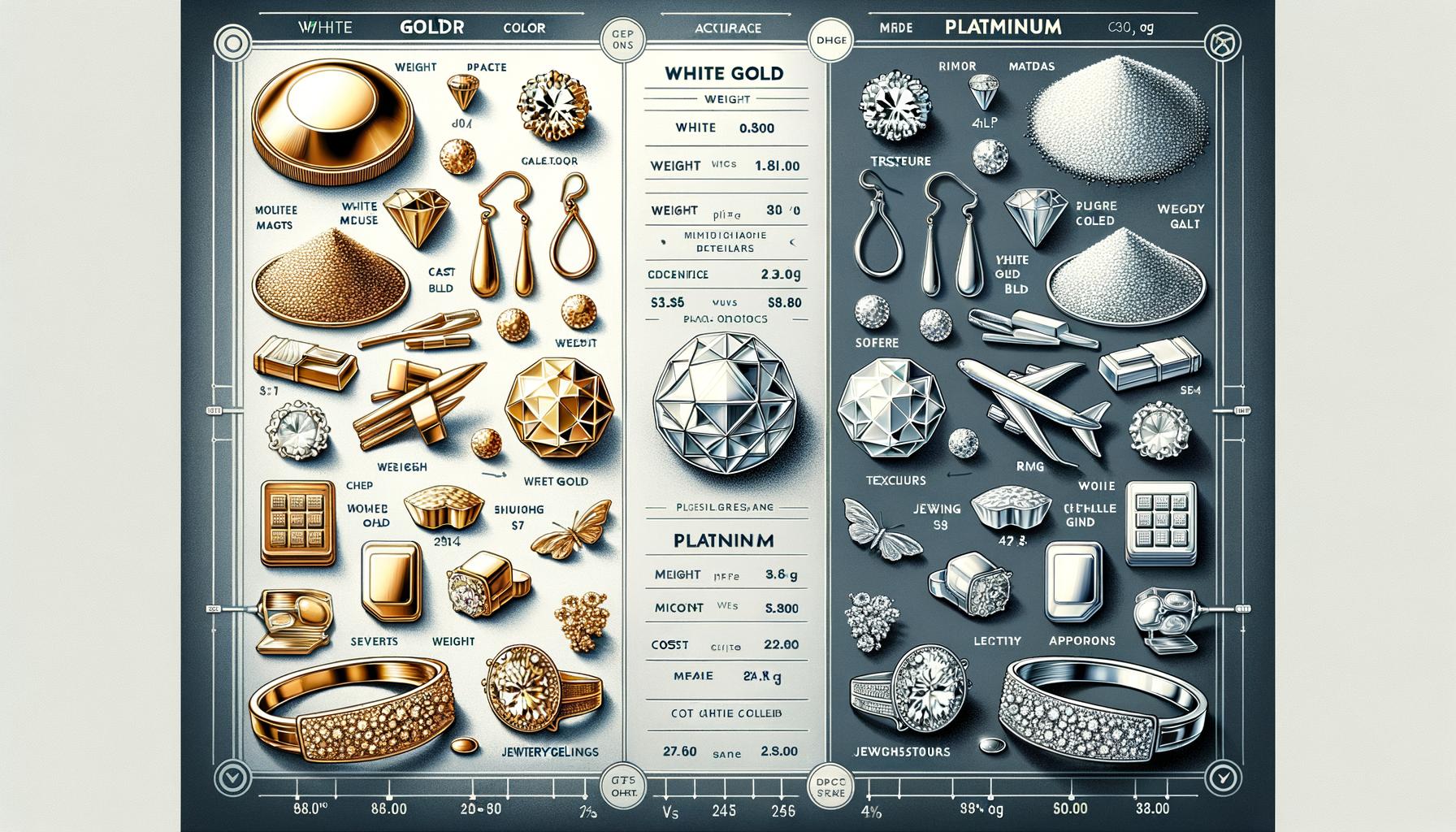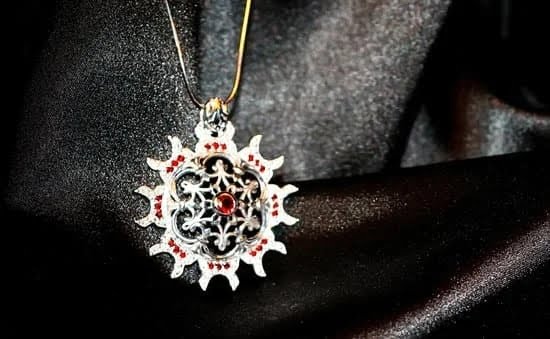When it comes to fine jewelry, two luxurious metals often come into consideration: white gold and platinum. While both have a stunning, silvery-white appearance that makes them popular choices for engagement rings, wedding bands, and other high-end pieces, understanding the differences between white gold and platinum is crucial for anyone contemplating a significant jewelry purchase.
Whether you’re preparing to pop the question or simply wanting to add a timeless piece to your collection, knowing what sets these metals apart can make all the difference in your decision-making process.
White gold and platinum each offer distinct advantages and characteristics that appeal to different tastes and needs. White gold is known for its blend of elegance and affordability, while platinum’s reputation lies in its unparalleled durability and hypoallergenic properties. For those planning a long-term investment in their jewelry pieces, especially items meant to be worn daily like wedding bands or heirloom necklaces, these factors are essential considerations.
Moreover, making an informed choice isn’t just about aesthetics; it also involves thinking about maintenance requirements, potential allergies, ethical implications of mining practices, and overall cost. This guide aims to delve into every aspect of these two precious metals so you can make an educated decision tailored to your individual preferences and lifestyle needs.
Understanding the nuances between white gold and platinum will ensure that the jewelry you select not only captivates the eye but also stands the test of time.
Chemical Composition and Properties
White gold and platinum, though similar in aesthetic, have distinct chemical compositions that significantly influence their properties and suitability for various types of jewelry. White gold is essentially an alloy made by blending yellow gold with white metals such as palladium or nickel to achieve its characteristic silvery hue.
The typical composition of white gold can range from 14k to 18k, signifying that it contains about 58% to 75% pure gold. Unlike white gold, platinum is a naturally occurring metal known for its high purity in jewelry applications, usually around 95-98% pure.
One of the defining chemical properties of these metals is density. Platinum stands out with its remarkably high density of about 21.45 grams per cubic centimeter compared to white gold’s approximate density of 14-19 grams per cubic centimeter depending on the specific alloy used.
This higher density makes platinum significantly heavier than white gold, which can feel more substantial and luxurious in hand. From a malleability perspective, both metals are highly workable but differ in their applications-the greater softness of platinum allows jewelers to create intricate settings that securely hold precious stones.
Another critical aspect where they diverge is resistance to tarnish and corrosion. Understanding the differences between white gold and platinum here can directly impact how a piece retains its appearance over time. Platinum’s excellent resistance to oxidation ensures it maintains its color and sheen without the need for periodic treatments. In contrast, white gold may develop a slightly yellowish tint as the rhodium plating typically applied to enhance its whiteness wears off, necessitating replating every few years for maintenance.
| Characteristics | White Gold | Platinum |
|---|---|---|
| Chemical Composition | Blend of Yellow Gold & White Metals like Palladium/Nickel (14k-18k) | 95-98% Pure Metal |
| Density (g/cm³) | Approx. 14-19 | 45 |
| Tarnish Resistance | Requires Periodic Rhodium Plating | Naturally Tarnish-resistant |
Understanding these fundamental differences offers insightful knowledge when choosing between white gold and platinum for long-lasting jewelry pieces tailored to individual preferences and lifestyle needs.
Appearance and Aesthetic Differences
When it comes to understanding the differences between white gold and platinum, one of the most noticeable aspects is their appearance and aesthetic qualities. White gold, as its name suggests, has a brilliant white hue that often shines with a bright luster. This is achieved by alloying yellow gold with other metals like palladium or nickel and then plating it with a thin layer of rhodium. The result is a strikingly reflective surface that mimics the appearance of pure platinum.
On the other hand, platinum possesses a naturally white sheen without any need for additional plating. It boasts a more subtle, yet equally beautiful shimmer compared to the high polish of rhodium-plated white gold.
Its color can be described as having a slight grayish tint which adds an element of understated elegance to any piece of jewelry made from this metal. Over time, while both metals will endure some changes due to wear and tear, their aging processes differ significantly; white gold may lose its rhodium layer, leading to a yellowish tinge requiring re-plating, whereas platinum develops a patina-a soft matte finish that many appreciate for its vintage charm.
Moreover, these aesthetic differences extend to how each metal holds up over time visually. White gold tends to retain its initial radiance well but necessitates periodic maintenance to keep up appearances because of the inevitable fading of its rhodium coating.
In contrast, platinum’s inherent durability means it doesn’t lose mass when scratched-any displaced material simply moves aside rather than wearing away like in softer metals such as white gold. Consequently, older platinum pieces not only exhibit years of graceful aging but often remain closer in appearance to their original pristine condition.
| Metal | Visual Characteristics |
|---|---|
| White Gold | Bright luster due to rhodium plating; may develop yellowish tinge over time if not maintained. |
| Platinum | Naturally white with subtle grayish tint; develops patina (soft matte finish) over time. |
Durability and Longevity
When considering the durability and longevity of white gold versus platinum, several factors come into play that highlights their distinct properties. White gold, which is typically an alloy composed of gold mixed with metals like nickel or palladium, tends to be more susceptible to wear and tear over time. This is due in part to its lower density and malleability when compared to platinum.
Platinum, known for its remarkable density and resilience, stands out as one of the most durable precious metals used in jewelry. Unlike white gold, which may require rhodium plating to maintain its luster and appearance, platinum maintains its natural sheen with much less maintenance.
Understanding the differences between white gold and platinum also involves looking at how each metal holds up under daily use. For instance, while both can withstand everyday wear reasonably well, platinum’s superior hardness ensures it remains less prone to scratches and dents.
Even when it does get scratched, the metal displaces rather than loses material – a phenomenon known as “patina,” which some people find desirable for its vintage look. On the other hand, scratches on white gold can remove some of the rhodium plating if present, exposing the yellowish tint of the underlying gold alloy.
The longevity aspect extends beyond just physical durability; it also encompasses how these metals age over time visually. Platinum retains its appearance without requiring additional treatments or coatings throughout its lifespan. It ages gracefully with a patinated finish that many consider charming. Conversely, white gold often needs periodic maintenance in the form of re-polishing and re-plating with rhodium to retain its bright white finish-a critical consideration for those seeking low-maintenance jewelry options.
| Aspect | White Gold | Platinum |
|---|---|---|
| Density | Lower density | Higher density |
| Malleability | More malleable (softer) | Less malleable (harder) |
| Tarnish Resistance | Requires rhodium plating for tarnish resistance | Naturally resistant to tarnish without platings |
| Aging Appearance | Tends to yellow if not re-plated regularly | Ages with a unique patina but stays naturally white |
These factors make platinum an attractive option for those prioritizing long-term endurance and minimal upkeep in their jewelry choices.
Maintenance and Care
Maintaining white gold and platinum jewelry requires different approaches, mainly due to their distinct compositions and properties. One essential aspect of understanding the differences between white gold and platinum is recognizing how each metal reacts over time and knowing the appropriate maintenance practices for both.
White gold, an alloy typically made by mixing pure gold with other metals such as nickel, palladium, or silver, often requires more frequent upkeep. It’s generally plated with rhodium to enhance its whiteness and luster. Over time, this rhodium plating can wear off, especially in items that receive a lot of wear like rings.
To keep white gold looking bright and shiny, regular rhodium re-plating every 12-18 months is recommended. Additionally, white gold should be cleaned routinely with mild soap and water followed by thorough drying with a soft cloth to prevent tarnishing.
Platinum, known for its durability and resistance to tarnish, demands less frequent maintenance compared to white gold. Understanding the differences between white gold and platinum underscores that while platinum may develop a patina-a natural aging process resulting in a slightly duller appearance-it does not require re-plating like white gold.
This patina is often appreciated for its antique look; however, those who prefer a polished finish can have their platinum pieces professionally buffed periodically to restore their original sheen. Like white gold, cleaning platinum regularly with mild soap and water helps maintain its appearance.
When storing either metal jewelry, it’s crucial to avoid contact with hard surfaces that could cause scratches. For both white gold and platinum pieces:
- Use separate fabric-lined compartments or individual soft pouches.
- Avoid exposing the jewelry to harsh chemicals found in household cleaners or beauty products.
- Remove jewelry during activities that could subject it to undue stress or impact.
By adopting these straightforward maintenance practices tailored to each metal’s unique characteristics, your cherished white gold or platinum pieces can retain their beauty and elegance for years to come.
Cost and Value
When it comes to understanding the differences between white gold and platinum, cost is a significant factor that influences many buyers’ decisions. Platinum generally has a higher price tag compared to white gold, primarily due to its rarity and heftier density. White gold is an alloy of gold mixed with other metals like nickel or palladium, which reduces its overall cost. Conversely, platinum is a purer metal in terms of composition and requires minimal additives, contributing to its premium pricing.
Raw Material and Manufacturing Costs
The costs associated with procuring raw materials for both metals significantly impact their market prices. Platinum’s scarcity in nature makes mining more labor-intensive and costly. Additionally, refining platinum involves complex processes that further increase its costs. In contrast, gold is more abundant and easier to mine. The additives used in creating white gold are also relatively inexpensive, making the alloy more affordable for consumers.
Long-Term Investment
For those looking at jewelry as a long-term investment, the value retention of both metals should be considered. Although platinum initially costs more upfront, it often holds its value well over time due to its durability and scarcity. That said, understanding the differences between white gold and platinum from an investment perspective can be crucial depending on market trends. Gold prices have historically been subject to fluctuations based on economic factors but still tend to appreciate over long periods.
Resale Value
When evaluating the cost-value proposition between these two metals, resale value becomes an essential consideration for many buyers. Because platinum does not wear down as quickly as white gold-thanks partly to its lower susceptibility to scratches-it may fetch a better resale price if maintained properly over time.
On the flip side, while white gold might require periodic rhodium plating to maintain its luster, this additional care can help preserve its aesthetic appeal should you decide to sell it later.
Overall, while choosing between white gold and platinum may seem daunting given their price disparities, focusing on factors such as longevity and resale potential can make your decision clearer.
Hypoallergenic Properties
Like many decisions related to jewelry, considering hypoallergenic properties is crucial for those with sensitive skin. Understanding the differences between white gold and platinum in this context can significantly affect one’s comfort and overall experience with these precious metals.
White Gold and Allergens
White gold is an alloy, meaning it’s made by combining gold with other metals such as nickel, palladium, or silver to enhance its strength and attain its characteristic white color. While this process makes white gold more durable than pure gold, it also introduces potential allergens. People who are allergic to nickel, one of the common metals used in white gold alloys, may experience itching, rashes, or even blistering if they wear jewelry containing it over time.
It’s essential to know that some jewelers offer nickel-free white gold options, but they might still contain other metals that could cause reactions for particularly sensitive individuals. Regular re-plating with rhodium can help minimize contact between the skin and these allergens but doesn’t entirely eliminate the risk.
Premium Purity of Platinum
On the other hand, platinum’s hypoallergenic nature stems from its high purity levels in jewelry-typically around 95-98%. This purity means that there are fewer additional metals involved that could provoke allergic reactions. Due to its dense and durable characteristics, platinum does not require alloys like nickel for reinforcement.
Therefore, individuals with metal sensitivities often find platinum a safer choice for everyday wear without worrying about skin irritation or other allergic responses. Considering these advantages makes platinum an attractive investment despite its higher cost when contemplating long-term comfort and safety.
Decision-Making Based on Sensitivities
When choosing between white gold and platinum based on hypoallergenic properties, it’s important to identify your specific sensitivities clearly. If you have a known metal allergy or generally reactive skin, investing in platinum jewelry may save you from discomfort later on.
For those who prefer the appearance of white gold but have sensitivity concerns, checking the composition of the alloy used by your jeweler is advisable-opting for nickel-free white gold or ensuring regular maintenance through re-plating can mitigate issues. In understanding the differences between white gold and platinum from a hypoallergenic perspective, consumers can better navigate their choices towards safe and stylish investments in fine jewelry.
Ethical and Environmental Considerations
When it comes to understanding the differences between white gold and platinum, it’s crucial not just to look at their physical properties or aesthetic appeal, but also to consider their ethical and environmental impact. Mining practices for both metals can have significant repercussions on the environment and local communities, which are vital factors for conscientious consumers.
White gold is an alloy composed mainly of gold mixed with other white metals such as palladium or nickel. The extraction process for gold typically involves mining techniques like open-pit mining and underground mining, which are notorious for their environmental footprint.
Issues related to these methods include land degradation, deforestation, and the contamination of water sources due to the use of toxic chemicals such as cyanide and mercury. In addition, many gold mines operate in areas where labor practices may not meet ethical standards, raising concerns about human rights violations.
Platinum mining also has its set of challenges. Platinum is primarily sourced from limited regions around the globe, including South Africa and Russia. The process is energy-intensive due to platinum’s density and rarity in ore form.
This results in significant carbon emissions and ecological disruption in mining areas. However, platinum mining tends to be more regulated compared to gold mining, often adhering to stricter environmental guidelines. Nonetheless, both metals face scrutiny regarding their impact on human health and ecosystems.
Consumers seeking more sustainable options have a few alternatives:
- Opt for recycled metals: Many jewelers now offer pieces made from recycled white gold or platinum.
- Look for ethical certifications: Ensure that your jewelry comes from companies that adhere to fair trade practices.
- Consider lab-grown options: While currently more common with gemstones like diamonds, some companies are working on lab-grown precious metals too.
By being aware of these ethical and environmental considerations, you can make more informed choices that align with your values when selecting between white gold and platinum.
Popular Uses in Jewelry
White gold and platinum both have their own unique appeal, making them popular choices in various types of jewelry. For engagement rings, the durability and brilliant shine of white gold often draw people in. Its slightly warmer hue can complement diamonds beautifully, adding a subtle elegance that many brides-to-be adore. On the other hand, platinum’s natural whiteness and hypoallergenic properties make it equally attractive for engagement and wedding rings, offering a premium feel that signifies lasting commitment.
Furthermore, necklaces and pendants are another common use for these metals. White gold offers flexibility in design due to its malleability, allowing jewelers to create intricate patterns that might be harder to achieve with platinum.
However, platinum’s strength ensures that even delicate designs maintain their integrity over time. When it comes to statement pieces or heirloom-quality jewelry, understanding the differences between white gold and platinum can significantly influence your choice; platinum’s sturdiness makes it ideal for necklaces intended as lifelong treasures.
In terms of bracelets and earrings, both metals offer distinct advantages as well. White gold is often selected for its lightweight nature, making it comfortable for daily wear without compromising on style or durability.
Platinum bracelets are favored in pieces designed for special occasions due to their substantial weight and luxurious feel. Earrings made from white gold tend to attract people looking for versatile options suitable for both casual and formal settings, while platinum earrings are chosen by those desiring an extra touch of exclusivity.
- Engagement Rings
- Necklaces & Pendants
- Bracelets
- Earrings
By examining these uses closely, one can better appreciate why understanding the differences between white gold and platinum is essential when purchasing jewelry tailored to specific needs or events.
Decision-Making Guide
When choosing between white gold and platinum for your jewelry, it’s essential to weigh various factors and personal preferences. Understanding the differences between white gold and platinum can play a crucial role in guiding your decision-making process. Use this section as a practical tool to navigate through the primary considerations.
Assess Your Lifestyle
One of the first questions you should ask yourself is about your lifestyle. If you lead an active lifestyle or work with your hands frequently, durability becomes a more significant issue.
As discussed earlier, platinum tends to be more durable than white gold, sustaining fewer scratches and demonstrating greater overall wear resistance. On the other hand, if you prefer something lighter that won’t add additional stress while wearing it daily, white gold could be more suitable due to its lighter weight.
Consider Maintenance and Care
Maintenance is another vital factor in deciding between these two metals. Platinum’s natural hue remains consistent over time and typically only needs periodic polishing to maintain its luster. However, understanding the differences between white gold and platinum also means knowing that white gold requires regular upkeep in the form of rhodium plating to retain its bright appearance. Think about whether you’re prepared for this periodic maintenance when making your choice.
Evaluate Budget Constraints
Another critical point is cost. Generally speaking, platinum costs more than white gold initially but can offer long-term value due to its low maintenance requirements and high durability. White gold might seem like a cheaper option upfront but factor in potential recurring costs for upkeep when planning your budget. Do an honest assessment of what you’re willing to spend not just at purchase but over the lifecycle of your piece.
Analyze Allergies and Skin Sensitivity
Lastly, take into consideration any skin sensitivities or allergies you may have. Platinum is hypoallergenic, making it an excellent choice for those with metal allergies or sensitive skin. White gold usually contains alloys like nickel which can cause allergic reactions in some individuals-even though less common varieties are becoming available designed specifically for sensitivity concerns.
By reviewing these aspects-lifestyle suitability, maintenance levels required, budget constraints, and potential allergens-you’ll be better equipped to make an informed decision regarding whether white gold or platinum fits best into your life.
Conclusion
As we conclude our exploration into understanding the differences between white gold and platinum, it’s clear that both metals offer distinct advantages and considerations. White gold, with its appealing luster and affordability, remains a popular choice for many jewelry enthusiasts. Its blend of beauty and economic value makes it an attractive option, especially for those mindful of budget constraints. However, prospective buyers should be aware of the need for periodic rhodium plating to maintain its appearance.
On the other hand, platinum stands out with its extraordinary durability and hypoallergenic properties. This metal retains its color and sheen over time without additional treatments, making it an excellent long-term investment for those who prefer low-maintenance jewelry or have sensitive skin. The higher cost of platinum often pays off in terms of longevity and reduced upkeep expenses.
Ultimately, when deciding between white gold and platinum for your next piece of jewelry, consider your lifestyle, skin sensitivity, maintenance preferences, and budget. By thoroughly understanding the differences between white gold and platinum, you can make a well-informed decision tailored to your personal needs. Both metals have their charms; the right choice depends on what aspects matter most to you in a cherished piece of jewelry.
Frequently Asked Questions
Is It Better to Get Platinum or White Gold?
The choice between platinum and white gold often comes down to personal preference and priorities. Platinum is typically more durable and hypoallergenic, making it a great option for people with sensitive skin or those who prefer a metal that is less likely to wear away over time.
On the other hand, white gold is usually more affordable and can offer similar aesthetic qualities to platinum when new, although it may require periodic rhodium plating to maintain its appearance.
Can You Visually Tell the Difference Between Platinum and White Gold?
Visually distinguishing between platinum and white gold can be challenging for an untrained eye because both metals have a similar silvery-white appearance. However, over time, platinum tends to develop a patina — a slight dullness that some find appealing whereas white gold can turn yellowish if not regularly rhodium plated.
Jewelers might differentiate them based on weight since platinum is denser and heavier than white gold.
What Is the Advantage of Having a White Gold Ring Over a Platinum Ring?
One of the advantages of having a white gold ring over a platinum ring is cost-effectiveness. White gold is generally much cheaper than platinum, allowing buyers to allocate their budget towards other features like higher quality diamonds or custom designs.
Additionally, white gold tends to have a brighter initial luster due to the rhodium plating it typically receives during manufacturing, which many people find visually appealing.

Welcome to my jewelry blog! My name is Sarah and I am the owner of this blog.
I love making jewelry and sharing my creations with others.
So whether you’re someone who loves wearing jewelry yourself or simply enjoys learning about it, be sure to check out my blog for insightful posts on everything related to this exciting topic!





